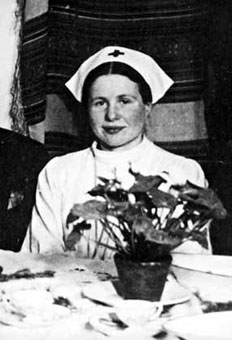
Irena Sendler, Humanitarian
| Published Thursday, January 23, 2014 |
By Earl H. Perkins
Thursday Review associate editor
They called her Jolanta, and she helped more than 2,500 Jewish children escape from the Warsaw Ghetto in World War II, with the Nazis escorting her in and out.
Irena Sendler was a Catholic social worker when the German occupation of Poland began in 1939, and a year later she watched in horror as German troops herded thousands of Jews into the Ghetto.
Soldiers walled off the area from the remainder of the city, barring social workers as diseases ran rampant—especially typhus. Sendler passed herself off as a nurse, bringing in food, clothes and medicine, supposedly helping ensure the disease didn’t spread to other parts of Warsaw.
As the war progressed into 1942, Sendler joined a Polish underground organization--Żegota, heading its Jewish children's section. She had a special permit to enter and leave the Ghetto, because she was an employee of the Social Welfare Department. She wore a Star of David during those visits, thus avoiding attention but also to show solidarity with the Jewish people.
Sendler worked with others in Warsaw’s Municipal Social Services department and the Central Welfare Council, which was a Polish relief organization the Germans tolerated.
When the operation first started, she recruited 10 close friends but that number eventually grew to 25. The children were smuggled out in boxes, suitcases, sacks and coffins, with babies being sedated to quiet their cries. Some were escorted through a network of basements and secret passages.
Some babies and small children were disguised as packages in burlap sacks and then secreted out in ambulances and trams. When Sendler drove the vehicle she used to smuggle children, under the guise of conducting inspections of sanitary conditions, she always brought along a dog that barked loudly, and consequently the German guards gave the dog and the vehicle a very wide berth.
The children were placed with Polish families, the Warsaw orphanage of the Sisters of the Family of Mary, or Roman Catholic convents.
Everyone remembers Oskar Schindler from the Academy Award-winning Schindler’s List, but Sendler’s life was no less fascinating, although few knew who she was until 1999. That’s when four Protestant high school students from rural Kansas wrote and performed the play Life in a Jar—the story of Sendler’s life. After all, she had become known as the female Oskar Schindler.
The children were taught Catholic prayers just in case guards were suspicious, and they were given non-Jewish aliases in their new homes. Their true names were recorded by Sendler on thin rolls of paper, which were eventually placed in jars and buried in a friend's garden. She dug up the jars after the war, hoping to perform family reunions, but most of the youngsters by then were orphans.
The Nazis captured and tortured her in 1943, but she did not reveal who the smugglers were, nor where the bottles were buried. Also, the women who worked in the prison laundry cut holes in the German soldiers’ underwear. The Nazi officers then lined up all the women, shooting every other one as punishment.
After the German’s discovered what Sendler had been doing, they put her through a horrible torture session. Both of her feet and legs were broken, and she passed out. When she woke up, a Gestapo officer told her he’d taken a bribe from her comrades to help her escape. Although she then went into hiding, she continued her rescue efforts.
Actually, Sendler may well have rescued approximately 500 other Jews--including the man she eventually married--before joining Zegota.
In 1965, Sendler was recognized by Israel with one of its highest humanitarian awards, and in Poland in October 2003 she was awarded the Order of the White Eagle, the highest civilian award in Poland, given to her for her brave work and tirelessness during the war.
For more information please go to: Virtual Jewish Library
